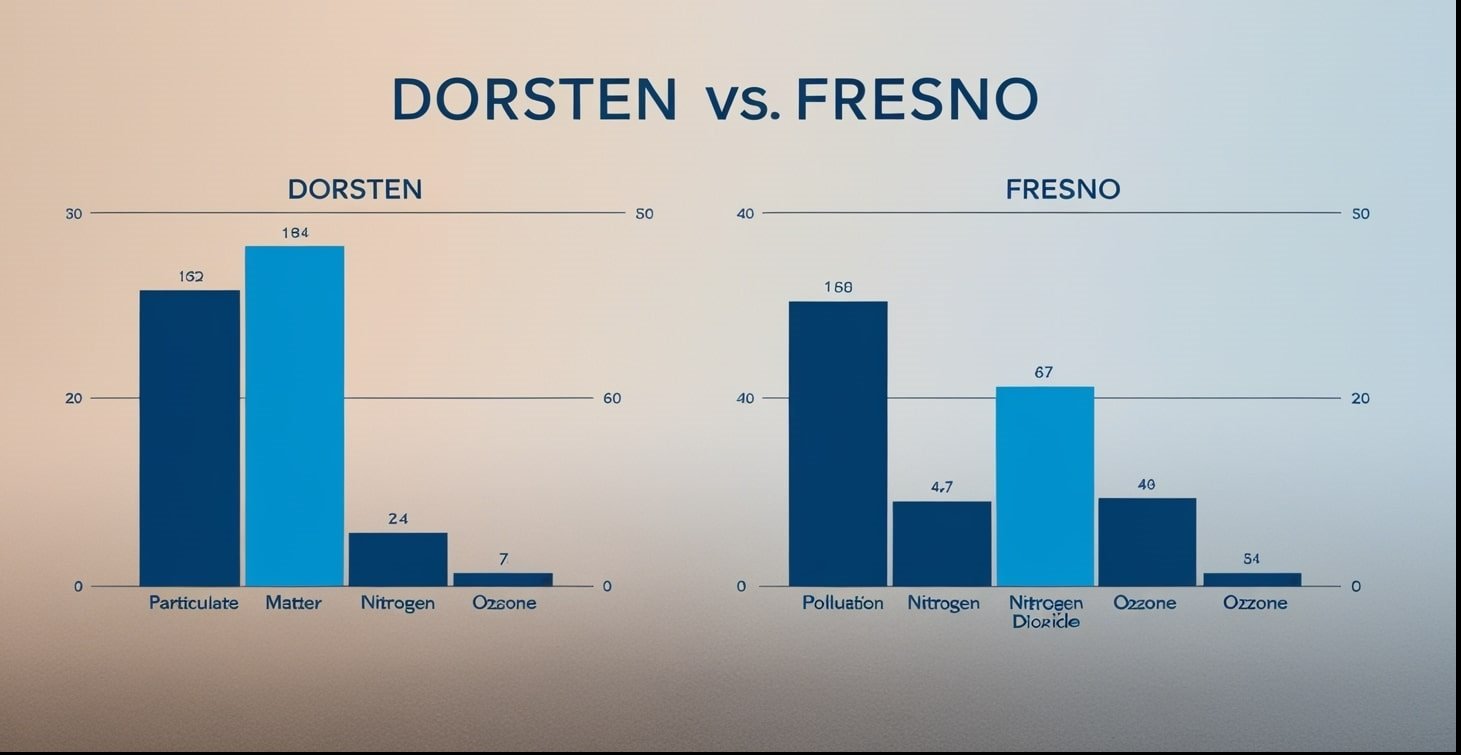Dorsten vs Fresno Pollution Comparison Chart: A Comprehensive Analysis
In an era where environmental concerns are at the forefront of global discussions, comparing pollution levels between cities has become increasingly important. This article presents a detailed “Dorsten vs Fresno pollution comparison chart” analysis, examining the air and water quality in these two distinct urban areas. By exploring the factors contributing to pollution in both Dorsten, Germany, and Fresno, California, we aim to provide valuable insights into urban environmental challenges and potential solutions.
Understanding the Cities
Dorsten: A Brief Overview
- Location: North Rhine-Westphalia, Germany
- Population: Approximately 75,000
- Key industries: Mining (historically), services, small-scale manufacturing
Fresno: A Brief Overview
- Location: Central California, United States
- Population: Approximately 540,000
- Key industries: Agriculture, manufacturing, healthcare
Dorsten vs Fresno Pollution Comparison Chart: Air Quality
Air Quality Index (AQI) Comparison
CityAverage AQIPM2.5 (μg/m³)PM10 (μg/m³)NO₂ (ppb)O₃ (ppb)Dorsten358.215.310.528.7Fresno5812.723.615.245.3
Note: Data represents annual averages. Lower values indicate better air quality.
Analysis of Air Quality Factors
Particulate Matter (PM)
The “Dorsten vs Fresno pollution comparison chart” reveals significant differences in particulate matter concentrations:
- PM2.5 (Fine Particulate Matter)
- Dorsten: 8.2 μg/m³
- Fresno: 12.7 μg/m³
- Agricultural activities (dust from farming)
- Wildfires in surrounding areas
- Higher traffic density
- PM10 (Coarse Particulate Matter)
- Dorsten: 15.3 μg/m³
- Fresno: 23.6 μg/m³
- Dust from construction sites
- Pollen from agricultural areas
- Industrial emissions
Nitrogen Dioxide (NO₂)
The “Dorsten vs Fresno pollution comparison chart” shows:
- Dorsten: 10.5 ppb
- Fresno: 15.2 ppb
Reasons for higher NO₂ levels in Fresno:
- Heavier traffic congestion
- More industrial activities
- Geographical factors (valley location trapping pollutants)
Ozone (O₃)
Ozone levels differ significantly:
- Dorsten: 28.7 ppb
- Fresno: 45.3 ppb
Fresno’s elevated ozone levels can be attributed to:
- Higher temperatures promoting ozone formation
- Abundant sunlight in the Central Valley
- Emissions from vehicles and industry
Dorsten vs Fresno Pollution Comparison Chart: Water Quality
Water Quality Parameters Comparison
ParameterDorstenFresnopH7.27.8Turbidity (NTU)0.51.2Nitrates (mg/L)2.35.7Chlorine (mg/L)0.30.8Lead (ppb)1.23.5Bacteria (CFU/100mL)<13
Note: Lower values generally indicate better water quality, except for pH where 7.0 is neutral.
Analysis of Water Quality Factors
pH Levels
The “Dorsten vs Fresno pollution comparison chart” shows:
- Dorsten: 7.2
- Fresno: 7.8
Both cities maintain pH levels within the acceptable range (6.5-8.5), but Fresno’s water is slightly more alkaline.
Turbidity
Turbidity levels differ:
- Dorsten: 0.5 NTU
- Fresno: 1.2 NTU
Fresno’s higher turbidity can be attributed to:
- Sediment from agricultural runoff
- Older water distribution infrastructure
Nitrates
Significant difference in nitrate levels:
- Dorsten: 2.3 mg/L
- Fresno: 5.7 mg/L
Factors contributing to Fresno’s higher nitrate levels:
- Intensive agricultural practices in the surrounding area
- Use of nitrogen-based fertilizers
- Groundwater contamination from septic systems
Chlorine
Chlorine levels vary:
- Dorsten: 0.3 mg/L
- Fresno: 0.8 mg/L
Fresno’s higher chlorine levels may be due to:
- Different water treatment practices
- Larger water distribution system requiring more disinfection
Lead
Lead concentrations show a notable difference:
- Dorsten: 1.2 ppb
- Fresno: 3.5 ppb
Possible reasons for Fresno’s higher lead levels:
- Older plumbing infrastructure in some areas
- Historical use of lead-containing materials
Bacteria
Bacterial presence in water:
- Dorsten: <1 CFU/100mL
- Fresno: 3 CFU/100mL
While both cities maintain low bacterial levels, Fresno’s slightly higher count may be due to:
- Differences in water treatment processes
- Potential contamination sources in the water supply system
Factors Influencing Pollution Levels
Geographical Considerations
- Dorsten
- Located in the Ruhr region, historically industrial
- Relatively flat terrain
- Proximity to other urban areas
- Fresno
- Situated in the San Joaquin Valley
- Surrounded by mountains, creating a bowl-like effect
- Prone to temperature inversions trapping pollutants
Climate and Weather Patterns
- Dorsten
- Temperate climate with mild summers and cool winters
- Regular rainfall helping to clean the air
- Less prone to extreme weather events
- Fresno
- Hot, dry summers and mild winters
- Limited rainfall, leading to dust and particulate accumulation
- Prone to drought conditions
Industrial and Agricultural Activities
- Dorsten
- Shift from heavy industry to service sector
- Smaller scale manufacturing
- Limited agricultural activities in the immediate vicinity
- Fresno
- Major agricultural hub with intensive farming practices
- Significant food processing industry
- Higher levels of industrial emissions
Transportation and Infrastructure
- Dorsten
- Well-developed public transportation system
- Emphasis on cycling infrastructure
- Lower reliance on personal vehicles
- Fresno
- Heavy reliance on personal vehicles
- Limited public transportation options
- Significant truck traffic due to agricultural and industrial activities
Environmental Policies and Initiatives
Dorsten’s Approach
- Renewable Energy Focus
- Significant investment in solar and wind energy
- Promotion of energy-efficient buildings
- Green Spaces
- Preservation and expansion of urban parks
- Green corridors connecting different parts of the city
- Water Management
- Advanced water treatment facilities
- Strict regulations on industrial water use and discharge
Fresno’s Strategies
- Air Quality Improvement Plans
- Collaboration with the San Joaquin Valley Air Pollution Control District
- Implementation of stricter vehicle emission standards
- Water Conservation Efforts
- Drought-resistant landscaping initiatives
- Groundwater recharge projects
- Sustainable Agriculture Practices
- Promotion of organic farming methods
- Reduction of pesticide and fertilizer use
Health Implications of Pollution Differences
The “Dorsten vs Fresno pollution comparison chart” reveals potential health impacts:
Respiratory Health
- Dorsten
- Lower incidence of asthma and other respiratory conditions
- Reduced risk of long-term lung damage from air pollution
- Fresno
- Higher rates of asthma, especially among children
- Increased risk of chronic obstructive pulmonary disease (COPD)
Cardiovascular Health
- Dorsten
- Lower risk of heart disease related to air pollution
- Reduced incidence of stroke
- Fresno
- Higher rates of cardiovascular diseases
- Increased risk of heart attacks due to poor air quality
Water-related Health Issues
- Dorsten
- Lower risk of waterborne diseases
- Reduced exposure to harmful chemicals in drinking water
- Fresno
- Higher incidence of nitrate-related health issues
- Potential long-term effects from exposure to contaminants
Economic Impact of Pollution Levels
Healthcare Costs
- Dorsten
- Lower healthcare expenditure related to pollution-induced illnesses
- Reduced burden on the healthcare system
- Fresno
- Higher healthcare costs due to pollution-related health issues
- Increased strain on medical facilities during poor air quality days
Tourism and Quality of Life
- Dorsten
- Attractive destination for eco-conscious tourists
- Higher quality of life attracting skilled workers
- Fresno
- Potential negative impact on tourism during high pollution periods
- Challenges in attracting and retaining talent due to environmental concerns
Agricultural Productivity
- Dorsten
- Limited impact on local agriculture
- Focus on sustainable farming practices
- Fresno
- Potential reduction in crop yields due to air pollution
- Increased costs for water treatment in agriculture
Future Outlook and Recommendations
Based on the “Dorsten vs Fresno pollution comparison chart”, we can propose the following recommendations:
For Dorsten
- Maintain and Enhance Current Practices
- Continue investment in renewable energy
- Further develop cycling infrastructure
- Promote green building technologies
- International Collaboration
- Share best practices with other cities
- Participate in global environmental initiatives
- Industry Innovation
- Encourage development of clean technologies
- Support research in environmental science
For Fresno
- Aggressive Air Quality Improvement
- Implement stricter emission controls for vehicles and industry
- Increase urban green spaces to act as natural air filters
- Promote electric vehicle adoption
- Water Quality Enhancement
- Upgrade water treatment facilities
- Implement stricter regulations on agricultural runoff
- Invest in groundwater protection measures
- Sustainable Urban Planning
- Develop more efficient public transportation systems
- Encourage high-density, mixed-use development to reduce vehicle dependency
- Implement green building codes for new constructions
- Agricultural Reforms
- Promote sustainable farming practices
- Encourage crop diversification to reduce water-intensive monocultures
- Implement precision agriculture techniques to minimize resource use
Conclusion
The “Dorsten vs Fresno pollution comparison chart” reveals significant differences in environmental quality between these two cities. While Dorsten benefits from stricter European environmental regulations and a shift away from heavy industry, Fresno faces challenges due to its geographical location, agricultural intensity, and historical urban development patterns.
Both cities can learn from each other’s experiences. Dorsten’s success in maintaining good air and water quality despite its industrial heritage offers valuable lessons for cities worldwide. Fresno, on the other hand, represents the challenges faced by many agricultural hubs and provides insights into the complex interplay between economic activities and environmental health.







